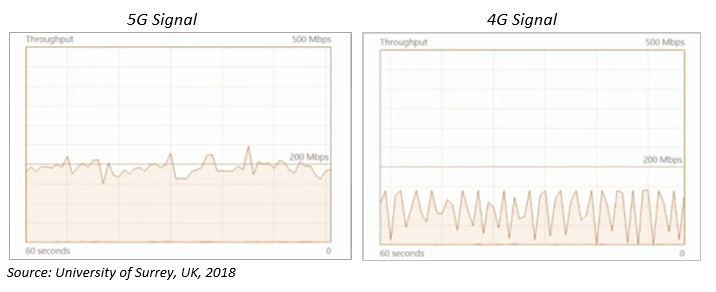It’s easy to think of 5G as just ‘faster Internet’. And while we can expect average up-and-downloading speeds to increase by 10x, with peak speeds up to 50x faster (50Gbps), speed is not the sole differentiator from 4G (5G.co.uk).
Let’s rewind six years ago to when 4G launched in Europe. At the time, we would’ve thought “well, it’s just faster 3G right?”. Fast-forward and we find ourselves comfortable staying in complete stranger’s houses, and even renting our own homes out to strangers, thanks to services like Airbnb.
This is not the output of 4G solely being faster than 3G. Airbnb, Uber, Deliveroo are the outputs of more reliable Internet (coverage), larger data packages, the rise of e-commerce and the emergence of the Internet of Things (IoT). All of which have built consumer confidence and trust with how and when we use the Internet. So why then is 5G not simply a continuation of 4G?
To start, the infrastructure is drastically different. When Ofcom auctioned the 5G spectrum last year, the bidding companies were competing for frequency in the 30-300GHz range. This is a big change to current frequencies around the 5GHz range (The Guardian, April 2018).
The frequencies are high enough to avoid interference from surrounding signals. It’s like building a new road across the UK no one is driving on.
Ever been to a concert, sporting event or supermarket and had no reception? That’s because everyone is competing for signal on the same frequency. 5G circumvents this, allowing 1,000+ more devices per square metre to connect to the signal (ASDA Mobile, Nov 2018).
Now, this also presents obstacles. 5G largely transmits data through small cells using millimetre waves. Due to the nature of the wavelengths, it’s harder for the signal to bend around solid objects such as buildings, windows and trees downloads (AdWeek, Feb 2018).
The upside, is that there is less latency and buffering. Looking at the diagrams below, we can see how the signal is transmitted differently between 4G and 5G.

5G signal is transmitted in a more linear manner. This is critical when we think of the increasing use of robotics for automation. If you have a driver-less car, you don’t want an inconsistent signal. Between each peak and trough in the signal are micro-moments of buffering – not ideal for a robot needing to perform a continuous task such as driving or surgery.
The 5G infrastructure offers increased bandwidth which is likely to see the IoT truly take off where everything is connected. We’ll start losing ‘dead-time’ and every minute can become productive. Brushing your teeth in the morning? Your smart mirror will tell you all your upcoming meetings, how best to get to them, and even make suggestions of what to wear based on how formal / casual your meetings are and what clothes are washed and in your wardrobe.
The bandwidth also enables one of the prime 5G use cases – image recognition. ASOS were an early mover here; their App allows you to take a picture of a clothing item and find the nearest matching product within their e-store.
So, when can we expect 5G? The UK’s six largest cities are the launch markets for mid-2019, with a number of large cities to follow by the end of the year. Due to the challenges of the signals passing through physical objects, it appears 5G will be in our homes and workplaces before our smartphones.
With 5G in our homes though it could remove the need to be in a physical workplace. 4G enabled mainstream video-streaming, remote VPNs and Cloud access which according to HR Director sees 4.2m people in the UK regularly working from home – approximately 12% of the UK working population. It will be interesting to see how workplaces evolve with faster speeds and more connected devices.
Ben McInerney
Head of Innovation, Wavemaker
